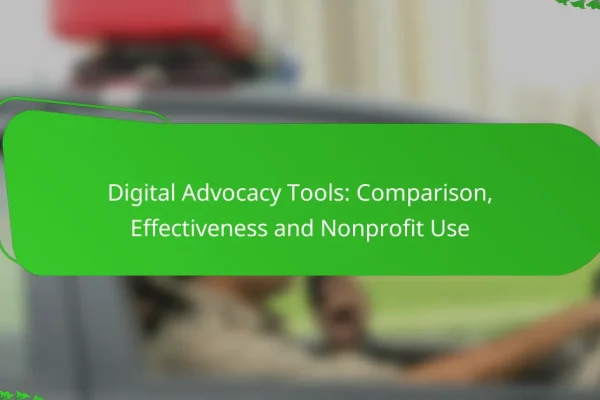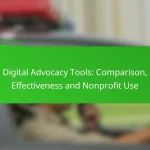What are the best digital advocacy tools for nonprofits?
The best digital advocacy tools for nonprofits streamline communication, mobilize supporters, and enhance fundraising efforts. These platforms offer various features tailored to the unique needs of nonprofit organizations, making it easier to engage with constituents and drive social change.
NationBuilder
NationBuilder is a comprehensive platform that combines website management, donor tracking, and campaign tools. It allows nonprofits to build a community by managing supporters, sending targeted communications, and analyzing engagement metrics.
Consider using NationBuilder if you need an all-in-one solution that integrates various functions. Its pricing varies based on the number of supporters you manage, making it suitable for organizations of different sizes.
EveryAction
EveryAction is designed for nonprofits looking to enhance their fundraising and advocacy efforts. It offers tools for email marketing, online donations, and volunteer management, all in one platform.
This tool is particularly beneficial for organizations that prioritize data-driven decision-making, as it provides robust analytics to track campaign performance. Pricing is tiered, accommodating small to large organizations.
Action Network
Action Network focuses on grassroots organizing and advocacy. It provides tools for creating petitions, event management, and email campaigns, enabling nonprofits to mobilize supporters effectively.
This platform is ideal for organizations that engage in activism and community organizing. Action Network operates on a pay-what-you-can model, making it accessible for smaller nonprofits.
Mobilize
Mobilize specializes in event management and volunteer engagement. It allows nonprofits to create events, manage registrations, and communicate with attendees seamlessly.
For organizations that rely heavily on events to drive engagement, Mobilize offers features like automated reminders and follow-ups. Its pricing is based on usage, which can be cost-effective for smaller groups.
Phone2Action
Phone2Action is a digital advocacy tool that helps nonprofits engage supporters through phone calls, text messages, and social media. It enables organizations to create campaigns that encourage constituents to contact their representatives directly.
This platform is particularly useful for advocacy efforts that require immediate action. Phone2Action’s pricing is based on the number of campaigns and features used, making it adaptable for various organizational needs.
How can digital advocacy tools enhance campaign effectiveness?
Digital advocacy tools can significantly boost campaign effectiveness by streamlining communication, improving outreach, and enabling data analysis. These tools help organizations connect with their audience more efficiently and make informed decisions based on real-time feedback.
Improved outreach capabilities
Digital advocacy tools enhance outreach by providing platforms for targeted messaging and broad distribution. Organizations can use social media, email campaigns, and online petitions to reach specific demographics, ensuring that their message resonates with the intended audience.
For example, using tools like Mailchimp for email marketing allows for segmentation of lists, enabling tailored content that speaks directly to different groups. This targeted approach can increase the likelihood of engagement and response.
Data-driven decision making
Data-driven decision making is crucial for optimizing advocacy campaigns. Digital tools collect and analyze data on audience behavior, engagement levels, and campaign performance, allowing organizations to adjust strategies in real time.
Utilizing analytics platforms like Google Analytics can provide insights into which messages are most effective, helping to refine future outreach efforts. Regularly reviewing this data ensures that campaigns remain relevant and impactful.
Increased engagement rates
Engagement rates can see a substantial increase through the use of interactive digital advocacy tools. Features such as polls, surveys, and social media interactions encourage audience participation and foster a sense of community.
For instance, organizations can implement live Q&A sessions or webinars to directly engage with their supporters, creating a more personal connection. This not only boosts engagement but also builds loyalty and trust among constituents.
What features should you look for in digital advocacy tools?
When selecting digital advocacy tools, prioritize features that enhance user engagement, streamline processes, and provide actionable insights. Key elements include a user-friendly interface, integration capabilities with existing systems, and robust analytics for measuring impact.
User-friendly interface
A user-friendly interface is crucial for ensuring that all team members can effectively utilize the advocacy tool without extensive training. Look for intuitive navigation, clear labeling, and accessible design that accommodates users of varying tech-savviness.
Consider tools that offer customizable dashboards, allowing users to prioritize the information most relevant to their advocacy efforts. A simple layout can significantly reduce the time spent on training and increase overall productivity.
Integration with CRM systems
Integration with Customer Relationship Management (CRM) systems is essential for maintaining streamlined communication and data management. Ensure the advocacy tool can easily connect with popular CRM platforms, enabling seamless data transfer and collaboration.
Check for features that allow automatic updates of contact information and engagement history. This integration helps in tracking interactions and tailoring advocacy strategies based on comprehensive data insights.
Analytics and reporting
Robust analytics and reporting capabilities are vital for measuring the effectiveness of advocacy campaigns. Look for tools that provide real-time data on engagement metrics, campaign performance, and audience reach.
Consider features that allow for customizable reports, enabling you to focus on specific metrics that matter most to your goals. Regularly reviewing these analytics can inform future strategies and improve overall advocacy efforts.
How do digital advocacy tools support grassroots movements?
Digital advocacy tools empower grassroots movements by enhancing communication, organization, and mobilization efforts. These tools streamline processes, enabling activists to connect with supporters and coordinate actions effectively.
Facilitating community organizing
Digital advocacy tools simplify community organizing by providing platforms for collaboration and information sharing. Tools like social media, messaging apps, and dedicated organizing software allow groups to create events, share resources, and foster discussions among members.
For effective community organizing, consider using tools that offer features such as event scheduling, document sharing, and real-time communication. Platforms like Slack or Facebook Groups can help maintain engagement and ensure everyone is informed about upcoming initiatives.
Mobilizing supporters quickly
Digital advocacy tools enable rapid mobilization of supporters through targeted messaging and outreach. Email campaigns, social media posts, and text alerts can quickly inform supporters about urgent actions, such as rallies or petitions.
To maximize mobilization efforts, utilize tools that allow for segmentation of your audience based on interests or demographics. This ensures that messages are relevant and timely, increasing the likelihood of participation. Aim to send alerts during peak engagement times, such as evenings or weekends, to reach the highest number of supporters.
What are the pricing models for digital advocacy tools?
Digital advocacy tools typically employ various pricing models to cater to different user needs and budgets. The most common models include subscription-based pricing, pay-per-use options, and freemium models, each with its own advantages and considerations.
Subscription-based pricing
Subscription-based pricing involves users paying a recurring fee, often monthly or annually, to access the digital advocacy tool. This model provides predictable costs and typically includes regular updates and customer support.
When considering this option, evaluate the features included in the subscription. Some tools may offer tiered pricing based on the number of users or additional features, which can range from low tens to several hundred dollars per month.
Pay-per-use options
Pay-per-use options charge users based on their actual usage of the digital advocacy tool. This model can be beneficial for organizations that do not need continuous access or have fluctuating demands.
Consider how usage is measured, whether by the number of actions taken, campaigns launched, or data processed. This model may lead to lower costs for infrequent users but can become expensive for high-volume usage.
Freemium models
Freemium models offer basic features for free while charging for advanced functionalities. This approach allows users to test the tool without financial commitment, making it appealing for smaller organizations or individuals.
However, be aware of the limitations of the free version, which may restrict access to essential features or impose usage caps. Upgrading to a paid tier often unlocks additional capabilities, which can range from a few dollars to several hundred dollars per month, depending on the tool’s complexity.
What are the challenges of using digital advocacy tools?
Digital advocacy tools face several challenges that can hinder their effectiveness. Key issues include technical barriers for users and concerns regarding data privacy, which can impact user engagement and trust.
Technical barriers for users
Many users encounter technical barriers when utilizing digital advocacy tools, such as complex interfaces or lack of digital literacy. These challenges can lead to frustration and reduced participation in advocacy efforts.
To mitigate these issues, organizations should prioritize user-friendly designs and provide clear instructions or tutorials. Offering support channels, like chat or email assistance, can also help users navigate these tools more effectively.
Data privacy concerns
Data privacy is a significant concern for users of digital advocacy tools, as individuals may worry about how their personal information is collected, stored, and used. This apprehension can deter potential advocates from engaging with these platforms.
Organizations must comply with relevant data protection regulations, such as the General Data Protection Regulation (GDPR) in Europe, to build trust. Transparency about data usage and providing users with control over their information can help alleviate these concerns and encourage participation.






